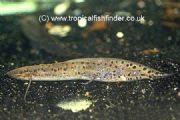Article categories:
Select a category below to view articles on each subject.
Search
Enter your keyword/s below to search :

Fish delivered straight to your door from Wildwoods
Hundreds of Species available today…
TFF Mailing List
Join the TFF mailing list today and we will email you with latest offers, news items and more.
Lung fish
Although not necessarily among the most attractive of the species available within the trade, Lungfish are arguably among the most unusual and interesting. They are capable of breathing atmospheric air via ‘lungs’, which are actually a modified swim bladder. These fish originate from swamps that dry up seasonally and are able to survive for several months buried in mud before water returns.
Taxonomy and Distribution
These fish are considered one of the oldest and most primitive fish on Earth; the earliest fossil of these fish dates back 350 million years ago and it is thought that at some point Lungfish were present all over the world. There are six species of lungfish, four of which originate from tropical Africa, one from Australia and one from South America.
All lungfish belong to the class Sarcopterigii and the subclass Dipnol. Dipnol is then split into two orders, Ceratodontiformes and Lepidosireniformes. Ceratodontiformes consists of the Queensland Lungfish (also known as the Australian Lungfish) Neoceratodus forsteri, which is the most primitive of the lungfish. Lepidosireniformes consists of the families Lepidosirenidae (the South American Lungfish) and Protopteridae (African Lungfishes).
Protopteridae consists of the sole genus Protopterus and is made up of the 4 species of African Lungfish; Protopterus aethiopicus, Protopterus amphibius, Protopterus annectens and Protepterus dolloi. Protopterus annectens is the species of African Lungfish most commonly sold in the trade. They are obligate air breathers so they must breathe atmospheric oxygen. The South American Lungfish (also known as the American Mud-Fish) Lepidosiren paradoxa is the sole species of the family Lepidosirenidae and is a member of the genus Lepidosiren.
General Care
Lungfish are not particular about water conditions, originating from anoxic (low in oxygen) swamps and are easy to care for. It is important, however that a tank large enough to house these fish is provided as some species can reach up to 6ft. Although they are not particularly active fish they should be provided enough room to fully stretch out. A large high quality filter (preferably an external canister filter) is also necessary as these fish can produce a lot of waste. Remember to provide hiding places and crevices. Artificial lighting should be dim and water movement kept to a minimum. Sandy substrates are preferable but not essential. Bi-weekly water changes of around 30% will ensure water quality remains desirable for these fish.
Lungfish are carnivorous and will readily eat any food such as fish, crabs and other meaty food. Avoid foods high in fat such as pork. Some species may be weaned onto pellet food.
Social Behaviour and Compatibility
Although not a particularly active fish, lungfish are best kept on their own. They are not aggressive, but are highly predatory and will eat any fish it sees as food. They are also solitary fish and so avoid keeping them with others of the same species.
Queensland Lungfish, Neoceratodus forsteri
This species of lungfish is protected by the Convention on International Trade in Endangered Species of Wild Fauna and Flora (CITES) and as such is does not appear in the trade outside of Australia very often, although some companies are approved by CITES for breeding and export. This species can reach up to 3ft and an aquarium of approximately 5-6ft or a heated pond is required. This species will tolerate a range of water types with a temperature between 10°C and 29°C. It will readily accept freshwater shrimp, snails and garden worms. Fish fillets and freshwater mussel meat along with algae wafers can also be provided.
South-American Lungfish Lepidosiren paradoxa
This fish is found throughout the majority of the Amazon Rainforest, especially in the Rio Paraguay and Rio Parana basins as well as in waters in Venezuela, Colombia, Peru, Paraguay, Argentina Brazil, French Guiana and Brazil. The species is found in slow-moving or stagnant anoxic waters. This species can live between 8-20 years in captivity and reach 4ft in length. Provide an aquarium at least 5ft in length. Live foods such as freshwater shrimp and garden worms should make up the majority of this species’ diet along with freshwater mussel and other meaty foods such as fish fillets.
African Lungfishes
The African Lungfishes are widespread throughout Africa being found in swamps and floodplains in Sierra Leone, Togo, Ivory Coast, Cameroon, Guinea, Burkina Faso, Niger, Central African Republic, Nigeria, Gambia, Ghana, Chad, Benin, Senegal, Kenya, Sudan and Malia. They are capable of reaching 6ft in length and an aquarium large enough to allow them to fully stretch out is required. A water temperature between 24-30°C is preferable for the African Lungfishes. They are omnivorous and so will eat vegetable matter, algae wafers, prawn, mussel and fish fillets.
Other fish articles:
Other fish articles you may be interested in are listed below, click an article for full details.
-
FISH ARTICLE
-
FISH ARTICLE
-
FISH ARTICLE
-
FISH ARTICLE






.jpg)

